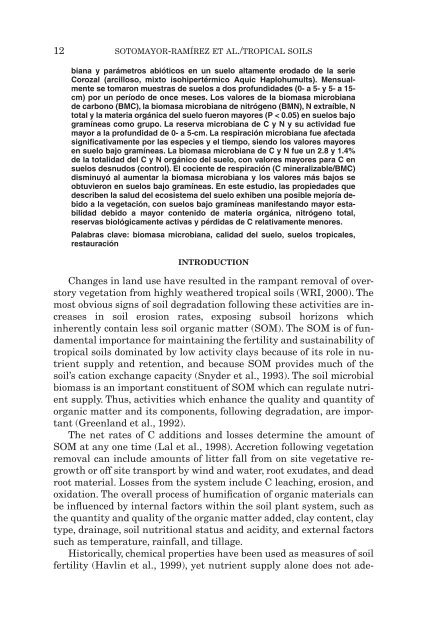Vegetation influence on soil quality in a highly degraded tropical ...
Vegetation influence on soil quality in a highly degraded tropical ...
Vegetation influence on soil quality in a highly degraded tropical ...
You also want an ePaper? Increase the reach of your titles
YUMPU automatically turns print PDFs into web optimized ePapers that Google loves.
12<br />
SOTOMAYOR-RAMÍREZ<br />
ET AL./<br />
TROPICAL SOILS<br />
biana y parámetros abióticos en un suelo altamente erodado de la serie<br />
Corozal (arcilloso, mixto isohipertérmico Aquic Haplohumults). Mensualmente<br />
se tomar<strong>on</strong> muestras de suelos a dos profundidades (0- a 5- y 5- a 15cm)<br />
por un período de <strong>on</strong>ce meses. Los valores de la biomasa microbiana<br />
de carb<strong>on</strong>o (BMC), la biomasa microbiana de nitrógeno (BMN), N extraíble, N<br />
total y la materia orgánica del suelo fuer<strong>on</strong> mayores (P < 0.05) en suelos bajo<br />
gramíneas como grupo. La reserva microbiana de C y N y su actividad fue<br />
mayor a la profundidad de 0- a 5-cm. La respiración microbiana fue afectada<br />
significativamente por las especies y el tiempo, siendo los valores mayores<br />
en suelo bajo gramíneas. La biomasa microbiana de C y N fue un 2.8 y 1.4%<br />
de la totalidad del C y N orgánico del suelo, c<strong>on</strong> valores mayores para C en<br />
suelos desnudos (c<strong>on</strong>trol). El cociente de respiración (C m<strong>in</strong>eralizable/BMC)<br />
dism<strong>in</strong>uyó al aumentar la biomasa microbiana y los valores más bajos se<br />
obtuvier<strong>on</strong> en suelos bajo gramíneas. En este estudio, las propiedades que<br />
describen la salud del ecosistema del suelo exhiben una posible mejoría debido<br />
a la vegetación, c<strong>on</strong> suelos bajo gramíneas manifestando mayor estabilidad<br />
debido a mayor c<strong>on</strong>tenido de materia orgánica, nitrógeno total,<br />
reservas biológicamente activas y pérdidas de C relativamente menores.<br />
Palabras clave: biomasa microbiana, calidad del suelo, suelos <strong>tropical</strong>es,<br />
restauración<br />
INTRODUCTION<br />
Changes <strong>in</strong> land use have resulted <strong>in</strong> the rampant removal of overstory<br />
vegetati<strong>on</strong> from <strong>highly</strong> weathered <strong>tropical</strong> <strong>soil</strong>s (WRI, 2000). The<br />
most obvious signs of <strong>soil</strong> degradati<strong>on</strong> follow<strong>in</strong>g these activities are <strong>in</strong>creases<br />
<strong>in</strong> <strong>soil</strong> erosi<strong>on</strong> rates, expos<strong>in</strong>g sub<strong>soil</strong> horiz<strong>on</strong>s which<br />
<strong>in</strong>herently c<strong>on</strong>ta<strong>in</strong> less <strong>soil</strong> organic matter (SOM). The SOM is of fundamental<br />
importance for ma<strong>in</strong>ta<strong>in</strong><strong>in</strong>g the fertility and susta<strong>in</strong>ability of<br />
<strong>tropical</strong> <strong>soil</strong>s dom<strong>in</strong>ated by low activity clays because of its role <strong>in</strong> nutrient<br />
supply and retenti<strong>on</strong>, and because SOM provides much of the<br />
<strong>soil</strong>’s cati<strong>on</strong> exchange capacity (Snyder et al., 1993). The <strong>soil</strong> microbial<br />
biomass is an important c<strong>on</strong>stituent of SOM which can regulate nutrient<br />
supply. Thus, activities which enhance the <strong>quality</strong> and quantity of<br />
organic matter and its comp<strong>on</strong>ents, follow<strong>in</strong>g degradati<strong>on</strong>, are important<br />
(Greenland et al., 1992).<br />
The net rates of C additi<strong>on</strong>s and losses determ<strong>in</strong>e the amount of<br />
SOM at any <strong>on</strong>e time (Lal et al., 1998). Accreti<strong>on</strong> follow<strong>in</strong>g vegetati<strong>on</strong><br />
removal can <strong>in</strong>clude amounts of litter fall from <strong>on</strong> site vegetative regrowth<br />
or off site transport by w<strong>in</strong>d and water, root exudates, and dead<br />
root material. Losses from the system <strong>in</strong>clude C leach<strong>in</strong>g, erosi<strong>on</strong>, and<br />
oxidati<strong>on</strong>. The overall process of humificati<strong>on</strong> of organic materials can<br />
be <str<strong>on</strong>g><strong>in</strong>fluence</str<strong>on</strong>g>d by <strong>in</strong>ternal factors with<strong>in</strong> the <strong>soil</strong> plant system, such as<br />
the quantity and <strong>quality</strong> of the organic matter added, clay c<strong>on</strong>tent, clay<br />
type, dra<strong>in</strong>age, <strong>soil</strong> nutriti<strong>on</strong>al status and acidity, and external factors<br />
such as temperature, ra<strong>in</strong>fall, and tillage.<br />
Historically, chemical properties have been used as measures of <strong>soil</strong><br />
fertility (Havl<strong>in</strong> et al., 1999), yet nutrient supply al<strong>on</strong>e does not ade-
















